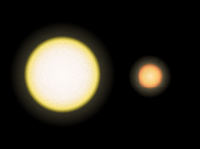
Photo from wikipedia
The geographic variation of terrestrial radiation can be exploited in epidemiological studies of the health effects of protracted low-dose exposure. Various methods have been applied to derive maps of this… Click to show full abstract
The geographic variation of terrestrial radiation can be exploited in epidemiological studies of the health effects of protracted low-dose exposure. Various methods have been applied to derive maps of this variation. We aimed to construct a map of terrestrial radiation for Switzerland. We used airborne γ-spectrometry measurements to model the ambient dose rates from terrestrial radiation through a Bayesian mixed-effects model and conducted inference using Integrated Nested Laplace Approximation (INLA). We predicted higher levels of ambient dose rates in the alpine regions and Ticino compared with the western and northern parts of Switzerland. We provide a map that can be used for exposure assessment in epidemiological studies and as a baseline map for assessing potential contamination.
Journal Title: Journal of environmental radioactivity
Year Published: 2021
Link to full text (if available)
Share on Social Media: Sign Up to like & get
recommendations!